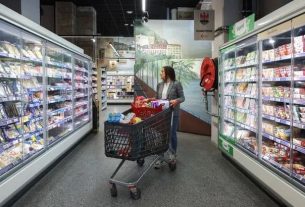On the eve of the end of the annual discussions between producers and distributors, nearly 70% of companies would have reached an agreement with the brands.
[Update Tuesday, February 28, 2023 at 11:45 a.m.: guest of Franceinfo this morning, Jean-Philippe André, president of the national association of food industries (Ania), confirmed that the annual negotiations were going to have a significant impact on shelf prices. “There are roughly 70% of companies that would have signed requests in the 10% range,” he said.]
Week after week, the bill goes up when you check out your supermarket. Like other everyday products, food has not escaped inflation.
In January 2023, food prices (fresh and other products) increased by an average of 13% in one year according to INSEE. The rise in prices even reached 15% for meat and almost 20% for milk, cheese and eggs.
But in March, it could be even worse. Experts fear spectacular inflation, even speaking of a “red march”. At issue: the annual negotiations between manufacturers and distributors which end this Wednesday, March 1, 2023, at midnight.
The impact of annual negotiations
It is an expression that has made the rounds of TV sets. Olivier Dauvers, retail expert, is the one who theorized the expression “mars rouge” last January. “It’s a simplistic term, but I assume it completely,” he told actu.fr.
Its goal: to alert the consumer to the consequences of the annual negotiations which apply in March and which will be unprecedented on prices.
Each year, from November 1 to February 28, processed products from major national brands are the subject of negotiations between suppliers and retailers. As a result of these discussions, new prices come into effect on our shelves.
Since the crisis, manufacturers have seen their production costs (energy, transport, wages) increase. And the latter will want to pass on the cost of these increases to the selling price of their manufactured products.
According to information from Olivier Dauvers, manufacturers have negotiated a price increase of between 7 and 8%.
An increase of 10% expected
Added to this is the food price inflation of around 2% in January 2023 (INSEE) which the consumer is already experiencing.
Thus, according to the retail expert, compared to the price we currently know, we would pay our supermarket products 10% more expensive.
Dominique Schelcher, president of the Super U brands, advanced the same figure on the antenna of France Inter this Monday 27th February 2023.
The lowest price war remains a compass
Grégory Caret, director of the Consumer Observatory ( ObSoCo ) calls for vigilance. “I find it hard to think that there will be such a violent repercussion,” he argues.
For the statistician, even if the inflationary context exists, competition between brands is still topical.
“By increasing its price by 10%, a supplier risks losing market share to gain margins. There is a trade-off between the two.”
However, Grégory Caret does not deny the probable “shock effect” that the annual negotiations on food inflation will have.
A visible price increase “in four to six weeks”
If this increase is inevitable, it will be necessary to wait a little before seeing its impact in our carts. Indeed, the consumer can be reassured: the new prices will not necessarily be on the shelves from March 1st .
Depending on the state of stocks , orders from brands and delivery times, the impact of annual negotiations will not be seen immediately. “We will see the effects in four to six weeks,” predicts retail expert Olivier Dauvers.
“Red Spring”
So, shouldn’t we rather speak of a “red spring”?
“It’s not just the month of March that will be red,” warns Lionel Maugain, purchasing power journalist for 60 Millions de consommateurs , who we contacted. “In reality, it’s until the summer that it’s going to be tough,” he continues.
This observation is confirmed by Grégory Caret of ObSoCo. The latter imagines more that the price increases resulting from the annual negotiations should be smoothed until the summer.
However, the expression “red spring” is not enough for him. It is essential to take a step back from the retail market.
“We had a red year 2022 and the beginning of 2023 follows the same path. Indeed, prices have been rising throughout the year.”
Prices rise all year round
If we are to fear an “annual negotiation effect”, we must, all the same, remember that prices can be revised at any time of the year.
Since the EGalim law 2 , adopted on October 18, 2021, the agreement includes an automatic price revision clause according to the variation in the cost of agricultural raw materials (little processed products).
Moreover, the negotiations concern only processed products. Other products have not waited to pass on the production costs to the shelves. This is the case with distributor brands (imitations of products from major brands, often at lower prices).
In January 2023, their prices increased by 18%, compared to 14% for national brands over one year according to ObSoCo.
A possible return to normal?
Each month, the announcement is the same: prices will increase further. Can we hope, one day, for a return to normal?
We still have to define what is normal. “Inflation can be expected to come down, but that won’t bring prices back to where they were before the crisis. The increase in wages is incompressible, ”said Olivier Dauvers.
The director of the Consumer Observatory is on the same line: “We must mourn the receipts of the beginning of the year 2022”, he warns.
Especially since it will soon be a year since food inflation is at record highs. The statistical analysis is done annually, we will soon compare the evolution of prices compared to months when inflation was already high in 2022.
The margins of the supermarkets in question
If the price hike is legitimate, it could be less than that. And it is Emmanuel Macron who says it .
Wandering around the Salon de l’Agriculture, the President of the Republic appealed to large retailers to fight against soaring prices. “The ones who have to make an effort on their margins are the distributors,” he said.
Each year, the Observatory of price formation and margins calculates the gross margins, that is to say, the difference between the purchase price and the price displayed in store of a product, on the shelves of your supermarkets (fishmongers, charcuterie, fruit and vegetables, etc.), at a national level.
Across all departments, the gross margin on purchase cost in relation to sales was 29.5% in 2020.




